Modulating Fish Gelatin Gelling Properties Through Furcellaran Addition: A Structural and Physicochemical Analysis
Abstract
1. Introduction
2. Results and Discussion
2.1. Textural Properties of FG Gels as Influenced by FUR Addition
2.1.1. Gel Strength
2.1.2. Texture Profile Analysis (TPA)
2.2. Intermolecular Forces of FG Gels as Influenced by FUR Addition
2.3. Changes in the Appearance of FG Gels as Influenced by FUR Addition
2.4. Syneresis of FG Gels as Influenced by FUR Addition
2.5. Rheological Behavior Analysis of FG Gels as Influenced by FUR Addition
2.6. Structural Property of FG Gels as Influenced by FUR Addition
2.6.1. SAXS Profiles
2.6.2. Microscopic Morphology
3. Conclusions
4. Materials and Methods
4.1. Materials
4.2. Preparation of Fish Gelatin/Furcellaran Samples
4.3. Analyses
4.3.1. Evaluation of Textural Properties
- Gel strength
- Texture Profile Analysis
4.3.2. Determination of Intermolecular Forces
4.3.3. Measurement of Color
4.3.4. Determination of Syneresis
4.3.5. Rheological Measurements
4.3.6. Small-Angle X-Ray Scattering (SAXS)
4.3.7. Microstructure
4.4. Statistical Analysis
Author Contributions
Funding
Institutional Review Board Statement
Informed Consent Statement
Data Availability Statement
Acknowledgments
Conflicts of Interest
References
- Avila Rodríguez, M.I.; Rodríguez Barroso, L.G.; Sánchez, M.L. Collagen: A review on its sources and potential cosmetic applications. J. Cosmet. Dermatol. 2018, 17, 20–26. [Google Scholar] [CrossRef] [PubMed]
- Barati, M.; Jabbari, M.; Navekar, R.; Farahmand, F.; Zeinalian, R.; Salehi-Sahlabadi, A.; Abbaszadeh, N.; Mokari-Yamchi, A.; Davoodi, S.H. Collagen supplementation for skin health: A mechanistic systematic review. J. Cosmet. Dermatol. 2020, 19, 2820–2829. [Google Scholar] [CrossRef]
- de Miranda, R.B.; Weimer, P.; Rossi, R.C. Effects of hydrolyzed collagen supplementation on skin aging: A systematic review and meta-analysis. Int. J. Dermatol. 2021, 60, 1449–1461. [Google Scholar] [CrossRef]
- Indriani, S.; Benjakul, S.; Quan, T.H.; Sitanggang, A.B.; Chaijan, M.; Kaewthong, P.; Petcharat, T.; Karnjanapratum, S. Effect of different ultrasound-assisted process modes on extraction yield and molecular characteristics of pepsin-soluble collagen from Asian bullfrog skin. Food Bioprocess Technol. 2023, 16, 3019–3032. [Google Scholar] [CrossRef]
- Lu, Y.; Luo, Q.; Chu, Y.; Tao, N.; Deng, S.; Wang, L.; Li, L. Application of gelatin in food packaging: A review. Polymers 2022, 14, 436. [Google Scholar] [CrossRef]
- Yasin, H.; Babji, A.S.; Norrakiah, A.S. Modification of chicken feet gelatin with aqueous sweet basil and lemongrass extract. LWT 2017, 77, 72–79. [Google Scholar] [CrossRef]
- Sinthusamran, S.; Benjakul, S.; Kishimura, H. Molecular characteristics and properties of gelatin from skin of seabass with different sizes. Int. J. Biol. Macromol. 2015, 73, 146–153. [Google Scholar] [CrossRef]
- Uddin, S.M.K.; Hossain, M.A.M.; Sagadevan, S.; Al Amin, M.; Johan, M.R. Halal and Kosher gelatin: Applications as well as detection approaches with challenges and prospects. Food Biosci. 2021, 44, 101422. [Google Scholar] [CrossRef]
- Liu, H.; Li, D.; Guo, S. Rheological properties of channel catfish (Ictalurus punctaus) gelatine from fish skins preserved by different methods. LWT 2008, 41, 1425–1430. [Google Scholar] [CrossRef]
- Wang, Y.; Cui, Q.; Wang, X.; Wu, C.; Xu, X.; Dong, X.; Pan, J. The gelling properties of fish gelatin as improved by ultrasound-assisted phosphorylation. Food Chem. 2024, 449, 139214. [Google Scholar] [CrossRef]
- Jongjareonrak, A.; Benjakul, S.; Visessanguan, W.; Tanaka, M. Skin gelatin from bigeye snapper and brownstripe red snapper: Chemical compositions and effect of microbial transglutaminase on gel properties. Food Hydrocoll. 2006, 20, 1216–1222. [Google Scholar] [CrossRef]
- Mohtar, N.F.; Perera, C.O.; Quek, S.-Y.; Hemar, Y. Optimization of gelatine gel preparation from New Zealand hoki (Macruronus novaezelandiae) skins and the effect of transglutaminase enzyme on the gel properties. Food Hydrocoll. 2013, 31, 204–209. [Google Scholar] [CrossRef]
- Sha, X.-M.; Fang, T.; Zhang, J.-H.; Shu, S.; Jiang, W.-L.; Hu, Z.-Z.; Tu, Z.-C. In vitro gastrointestinal digestion of thermally reversible and irreversible fish gelatin induced by microbial transglutaminase. Food Hydrocoll. 2023, 145, 109079. [Google Scholar] [CrossRef]
- Kaewdang, O.; Benjakul, S. Effect of ethanolic extract of coconut husk on gel properties of gelatin from swim bladder of yellowfin tuna. LWT 2015, 62, 955–961. [Google Scholar] [CrossRef]
- Demircan, H.; Oral, R.A.; Toker, O.S.; Palabiyik, I. Investigation of the effects of phenolic extracts obtained from agro-industrial food wastes on gelatin modification. ACS Omega 2024, 9, 20263–20276. [Google Scholar] [CrossRef]
- Temdee, W.; Benjakul, S.; Surasani, V.K.R.; Singh, A. Effects of ethanolic extract of kiam wood/cashew bark and commercial phenolic compounds oxidized under alkaline condition on gel property of gelatin from cuttlefish skin. Aquat. Food Stud. 2021, 1, AFS14. [Google Scholar] [CrossRef]
- Sinthusamran, S.; Benjakul, S.; Hemar, Y. Rheological and sensory properties of fish gelatin gels as influenced by agar from Gracilaria tenuistipitata. Int. J. Food Sci. Technol. 2016, 51, 1530–1536. [Google Scholar] [CrossRef]
- Cheng, Z.; Zhang, B.; Qiao, D.; Yan, X.; Zhao, S.; Jia, C.; Niu, M.; Xu, Y. Addition of κ-carrageenan increases the strength and chewiness of gelatin-based composite gel. Food Hydrocoll. 2022, 128, 107565. [Google Scholar] [CrossRef]
- Sinthusamran, S.; Benjakul, S.; Swedlund, P.J.; Hemar, Y. Physical and rheological properties of fish gelatin gel as influenced by κ-carrageenan. Food Biosci. 2017, 20, 88–95. [Google Scholar] [CrossRef]
- Haug, I.J.; Draget, K.I.; Smidsrød, O. Physical behaviour of fish gelatin-κ-carrageenan mixtures. Carbohydr. Polym. 2004, 56, 11–19. [Google Scholar] [CrossRef]
- Yuan, K.; Yang, X.; Li, D.; Wang, G.; Wang, S.; Guo, Y.; Yang, X. Incorporation of Nicandra physalodes (Linn.) Gaertn. pectin as a way to improve the textural properties of fish gelatin gels. Food Hydrocoll. 2022, 131, 107790. [Google Scholar]
- Huang, T.; Tu, Z.-c.; Wang, H.; Shangguan, X.; Zhang, L.; Zhang, N.-h.; Bansal, N. Pectin and enzyme complex modified fish scales gelatin: Rheological behavior, gel properties and nanostructure. Carbohydr. Polym. 2017, 156, 294–302. [Google Scholar] [CrossRef]
- Wang, J.; Zhao, X.; Zhou, C.; Wang, C.; Zheng, Y.; Ye, K.; Li, C.; Zhou, G. Effects of gellan gum and inulin on mixed-gel properties and molecular structure of gelatin. Food Sci. Nutr. 2021, 9, 1336–1346. [Google Scholar] [CrossRef]
- Lau, M.H.; Tang, J.; Paulson, A.T. Texture profile and turbidity of gellan/gelatin mixed gels. Food Res. Int. 2000, 33, 665–671. [Google Scholar] [CrossRef]
- Khorshidi, S.; Khoobbakht, F.; Mirmoghtadaie, L.; Hosseini, S.M. Characterization of gellan gum-chitosan based hydrogel to evaluate as a potential gelatin substitute. Food Hydrocoll. 2023, 145, 109038. [Google Scholar] [CrossRef]
- Petcharat, T.; Benjakul, S. Property of fish gelatin gel as affected by the incorporation of gellan and calcium chloride. Food Biophys. 2017, 12, 339–347. [Google Scholar] [CrossRef]
- Petcharat, T.; Benjakul, S.; Hemar, Y. Improvement of gel properties of fish gelatin using gellan. Int. J. Food Eng. 2017, 13, 1–10. [Google Scholar] [CrossRef]
- Laos, K.; Brownsey, G.; Ring, S. Interactions between furcellaran and the globular proteins bovine serum albumin and β-lactoglobulin. Carbohydr. Polym. 2007, 67, 116–123. [Google Scholar] [CrossRef]
- Jamróz, E.; Kulawik, P.; Krzyściak, P.; Talaga-Ćwiertnia, K.; Juszczak, L. Intelligent and active furcellaran-gelatin films containing green or pu-erh tea extracts: Characterization, antioxidant and antimicrobial potential. Int. J. Biol. Macromol. 2019, 122, 745–757. [Google Scholar] [CrossRef]
- Petcharat, T.; Chaijan, M.; Karnjanapratum, S. Effect of furcellaran incorporation on gel properties of sardine surimi. Int. J. Food Sci. Technol. 2021, 56, 5957–5967. [Google Scholar] [CrossRef]
- Montero, P.; Hurtado, J.L.; Pérez-Mateos, M. Microstructural behaviour and gelling characteristics of myosystem protein gels interacting with hydrocolloids. Food Hydrocoll. 2000, 14, 455–461. [Google Scholar] [CrossRef]
- Chen, H.; Wu, D.; Ma, W.; Wu, C.; Liu, J.; Du, M. Strong fish gelatin hydrogels double crosslinked by transglutaminase and carrageenan. Food Chem. 2022, 376, 131873. [Google Scholar] [CrossRef]
- Chung, D. Fish gelatin: Molecular interactions and applications. In Biopolymer-Based Formulations; Pal, K., Banerjee, I., Sarkar, P., Kim, D., Deng, W.-P., Dubey, N.K., Majumder, K., Eds.; Elsevier: Amsterdam, The Netherlands, 2020; pp. 67–85. [Google Scholar]
- Szczesniak, A.S. Classification of textural characteristics. J. Food Sci. 1963, 28, 385–389. [Google Scholar] [CrossRef]
- Faber, T.J.; Jaishankar, A.; McKinley, G.H. Describing the firmness, springiness and rubberiness of food gels using fractional calculus. Part I: Theoretical framework. Food Hydrocoll. 2017, 62, 311–324. [Google Scholar] [CrossRef]
- Benjakul, S.; Kittiphattanabawon, P.; Regenstein, J.M. Fish gelatin. In Food Biochemistry and Food Processing, 2nd ed.; Simpson, B.K., Ed.; John Wiley & Sons, Inc.: Hoboken, NJ, USA, 2012; pp. 388–405. [Google Scholar]
- Nussinovitch, A. Hydrocolloid Applications: Gum Technology in the Food and Other Industries; Springer: Berlin/Heidelberg, Germany, 1997. [Google Scholar]
- Kaewruang, P.; Benjakul, S.; Prodpran, T.; Encarnacion, A.B.; Nalinanon, S. Impact of divalent salts and bovine gelatin on gel properties of phosphorylated gelatin from the skin of unicorn leatherjacket. LWT 2014, 55, 477–482. [Google Scholar] [CrossRef]
- Wangtueai, S.; Noomhorm, A.; Regenstein, J.M. Effect of microbial transglutaminase on gel properties and film characteristics of gelatin from lizardfish (Saurida spp.) scales. J. Food Sci. 2010, 75, C731–C739. [Google Scholar] [CrossRef]
- Liu, C.; Song, J.; Wang, L.; Wang, P.; Ma, J.; Zhao, B.; Chen, X.; Wang, Y.; Zhang, W.; Wen, P. The impacts of different modification techniques on the gel properties and structural characteristics of fish gelatin. Food Hydrocoll. 2025, 158, 110536. [Google Scholar] [CrossRef]
- Wang, Y.; Han, L.; Yu, W.; Zhao, W.; Pan, J.; Prakash, S.; Dong, X. Carrageenan addition improves the melting temperature and 3D printing performance of the gelatin system. Food Hydrocoll. 2023, 144, 108918. [Google Scholar] [CrossRef]
- Geng, H.; Sun, W.; Zhan, S.; Jia, R.; Lou, Q.; Huang, T. Glycosylation with different saccharides on the gelling, rheological and structural properties of fish gelatin. Food Hydrocoll. 2024, 150, 109699. [Google Scholar] [CrossRef]
- Zhang, Z.; Yang, Y.; Tang, X.; Chen, Y.; You, Y. Chemical forces and water holding capacity study of heat-induced myofibrillar protein gel as affected by high pressure. Food Chem. 2015, 188, 111–118. [Google Scholar] [CrossRef]
- Chilvers, G.R.; Morris, V.J. Coacervation of gelatin-gellan gum mixtures and their use in microencapsulation. Carbohydr. Polym. 1987, 7, 111–120. [Google Scholar] [CrossRef]
- Glicksman, M. Red seaweed extracts (agar, carrageenans, furcellaran). In Food Hydrocolloid; CRC Press: Boca Raton, FL, USA, 2019; pp. 73–113. [Google Scholar]
- Kulawik, P.; Jamróz, E.; Tkaczewska, J.; Vlčko, T.; Zając, M.; Guzik, P.; Janik, M.; Tadele, W.; Golian, J.; Milosavljević, V. Application of antimicrobial chitosan-Furcellaran-hydrolysate gelatin edible coatings enriched with bioactive peptides in shelf-life extension of pork loin stored at 4 and −20 °C. Int. J. Biol. Macromol. 2024, 254, 127865. [Google Scholar] [CrossRef] [PubMed]
- Song, D.-H.; Hoa, V.B.; Kim, H.W.; Khang, S.M.; Cho, S.-H.; Ham, J.-S.; Seol, K.-H. Edible films on meat and meat products. Coatings 2021, 11, 1344. [Google Scholar] [CrossRef]
- Chen, K.; Vyazovkin, S. Temperature dependence of sol-gel conversion kinetics in gelatin-water system. Macromol. Biosci. 2009, 9, 383–392. [Google Scholar] [CrossRef]
- Wu, Q.; Buijs, J.; de Groot, S.; van der Kooij, H.M.; van der Gucht, J.; Kodger, T.E. Spatially heterogenous dynamics in colloidal gels during syneresis. Soft Matter 2023, 19, 5336–5344. [Google Scholar] [CrossRef]
- Khoobbakht, F.; Khorshidi, S.; Bahmanyar, F.; Hosseini, S.M.; Aminikhah, N.; Farhoodi, M.; Mirmoghtadaie, L. Modification of mechanical, rheological and structural properties of agar hydrogel using xanthan and locust bean gum. Food Hydrocoll. 2024, 147, 109411. [Google Scholar] [CrossRef]
- Wang, C.; Su, K.; Sun, W.; Huang, T.; Lou, Q.; Zhan, S. Comparative investigations of various modification methods on the gelling, rheological properties and mechanism of fish gelatin. Food Chem. 2023, 426, 136632. [Google Scholar] [CrossRef]
- Hu, Z.-Z.; Sha, X.-M.; Ye, Y.-H.; Xiao, W.-R.; Tu, Z.-C. Effects of γ-polyglutamic acid on the gelling properties and non-covalent interactions of fish gelatin. J. Texture Stud. 2020, 51, 511–520. [Google Scholar] [CrossRef]
- Wu, C.; Wang, J.; Yan, X.; Ma, W.; Wu, D.; Du, M. Effect of partial replacement of water-soluble cod proteins by soy proteins on the heat-induced aggregation and gelation properties of mixed protein systems. Food Hydrocoll. 2020, 100, 105417. [Google Scholar] [CrossRef]
- Wisotzki, E.I.; Tempesti, P.; Fratini, E.; Mayr, S.G. Influence of high energy electron irradiation on the network structure of gelatin hydrogels as investigated by small-angle X-ray scattering (SAXS). Phys. Chem. Chem. Phys. 2017, 19, 12064–12074. [Google Scholar] [CrossRef]
- Ji, Z.; Yu, L.; Duan, Q.; Miao, S.; Liu, H.; Shen, W.; Jin, W. Morphology and rheology of a cool-gel (protein) blended with a thermo-gel (hydroxypropyl methylcellulose). Foods 2022, 11, 128. [Google Scholar] [CrossRef] [PubMed]
- Yu, X.; Zhao, Z.; Zhang, N.; Yan, B.; Gao, W.; Huang, J.; Zhao, J.; Zhang, H.; Chen, W.; Fan, D. Effects of preheating-induced denaturation treatments on the printability and instant curing property of soy protein during microwave 3D printing. Food Chem. 2022, 397, 133682. [Google Scholar] [CrossRef] [PubMed]
- Banerjee, S.; Bhattacharya, S. Compressive textural attributes, opacity and syneresis of gels prepared from gellan, agar and their mixtures. J. Food Eng. 2011, 102, 287–292. [Google Scholar] [CrossRef]
- Steel, R.G.D.; Torrie, J.H. Principles and Procedures of Statistics; McGraw-Hill: New York, NY, USA, 1980. [Google Scholar]
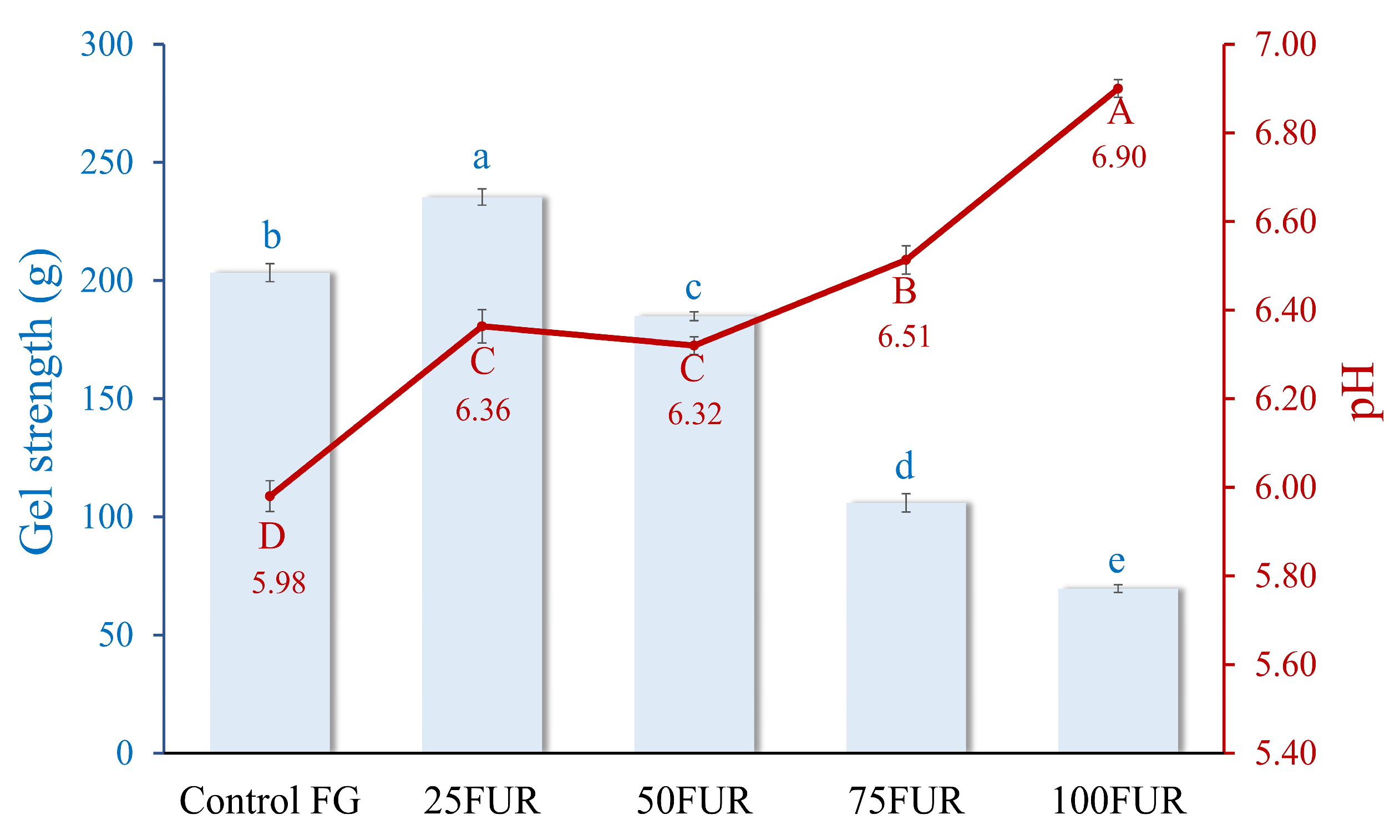
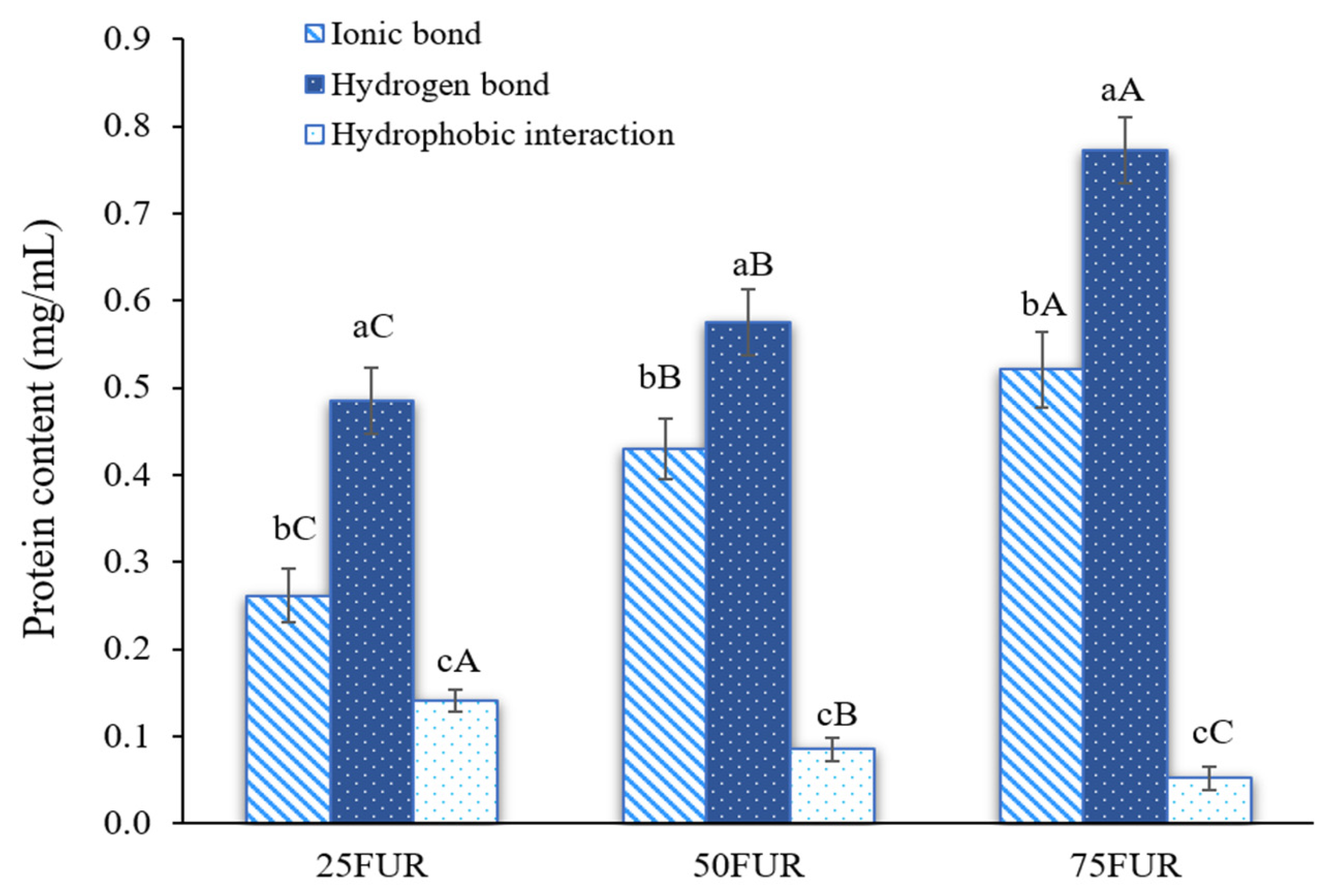
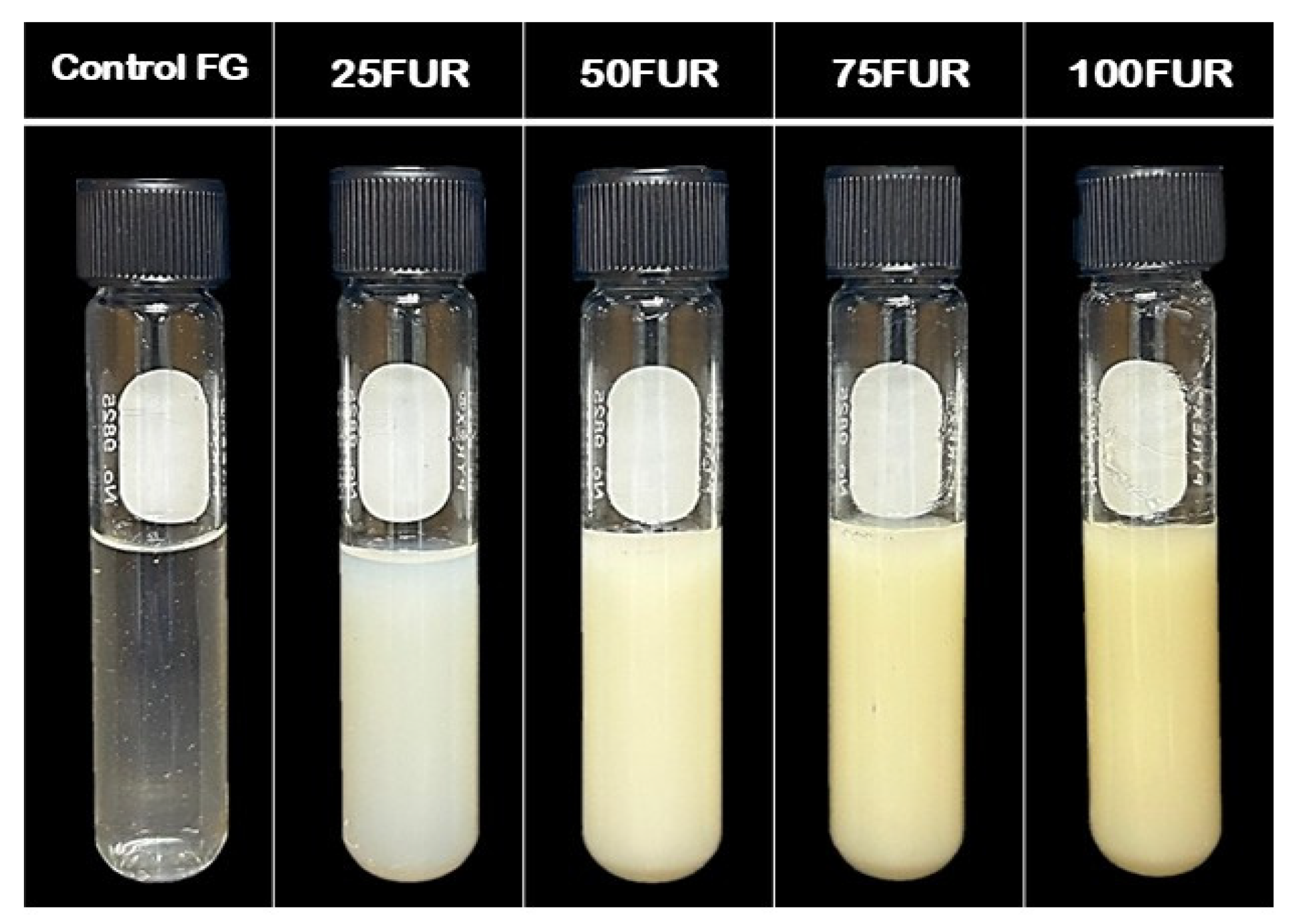
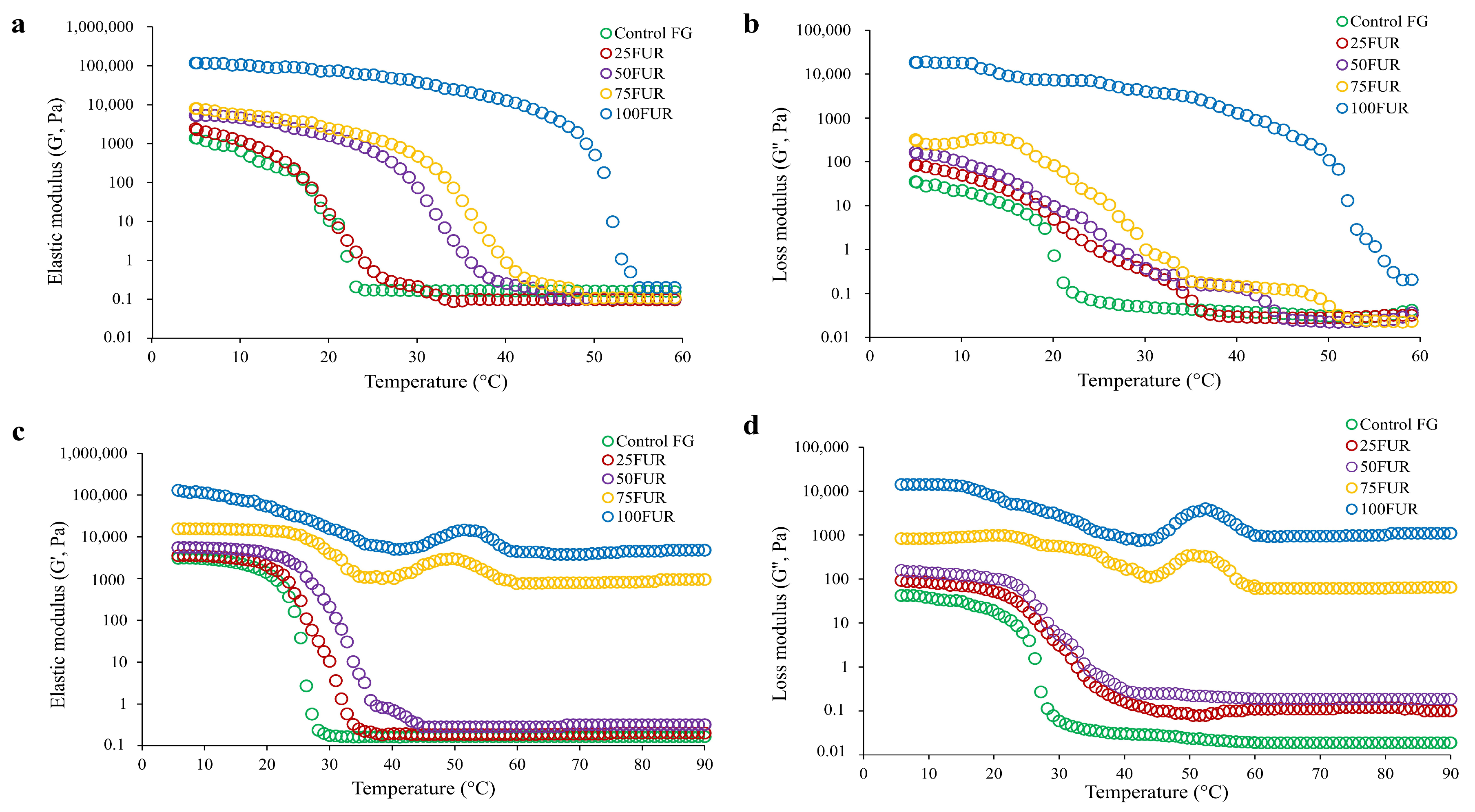
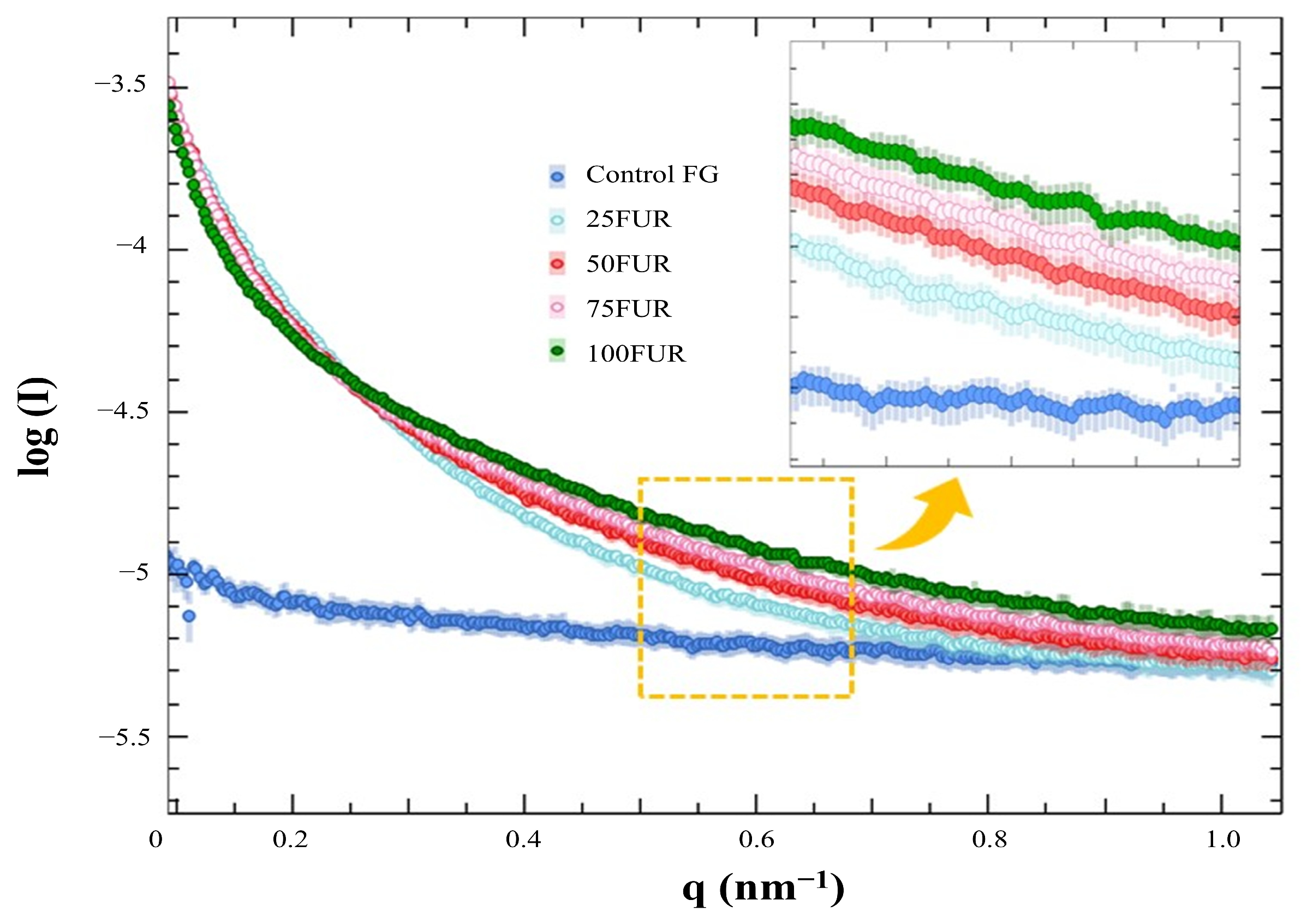

| Samples | Hardness (N) | Springiness | Cohesiveness | Gumminess (N) | Chewiness (N × mm) |
|---|---|---|---|---|---|
| Control FG | 14.40 ± 0.28 b | 0.96 ± 0.01 a | 0.90 ± 0.03 a | 12.48 ± 0.18 b | 12.00 ± 0.23 b |
| 25FUR | 18.42 ± 0.42 a | 0.95 ± 0.00 a | 0.88 ± 0.01 a | 14.69 ± 0.39 a | 14.02 ± 0.33 a |
| 50FUR | 12.08 ± 0.23 c | 0.91 ± 0.01 b | 0.76 ± 0.02 b | 10.25 ± 0.46 c | 9.35 ± 0.41 c |
| 75FUR | 9.34 ± 0.27 d | 0.79 ± 0.02 c | 0.66 ± 0.01 c | 8.33 ± 0.38 d | 6.61 ± 0.30 d |
| 100FUR | 6.57 ± 1.26 e | 0.52 ± 0.07 d | 0.49 ± 0.04 d | 8.22 ± 0.31 d | 4.29 ± 0.52 e |
| Samples | L* | a* | b* | ∆E* |
|---|---|---|---|---|
| Control FG | 70.68 ± 0.50 a | −2.20 ± 0.33 b | 8.85 ± 0.08 e | 21.18 ± 0.14 e |
| 25FUR | 67.13 ± 0.55 b | 1.75 ± 0.03 a | 10.91 ± 0.05 d | 33.06 ± 0.12 d |
| 50FUR | 63.34 ± 0.84 c | 2.00 ± 0.42 a | 13.28 ± 0.53 c | 34.75 ± 0.75 c |
| 75FUR | 61.26 ± 0.29 d | 2.19 ± 0.20 a | 14.79 ± 0.68 b | 38.04 ± 0.54 b |
| 100FUR | 54.81 ± 0.13 e | 2.15 ± 0.02 a | 16.14 ± 0.32 a | 41.27 ± 0.50 a |
| Samples | Syneresis (%) | Gelling Temperature (°C) | Melting Temperature (°C) |
|---|---|---|---|
| Control FG | 0.13 ± 0.04 c | 19.72 ± 0.59 e | 26.38 ± 0.71 e |
| 25FUR | 0.18 ± 0.03 c | 34.96 ± 0.43 d | 39.78 ± 0.57 d |
| 50FUR | 0.26 ± 0.01 bc | 39.19 ± 0.17 c | 43.75 ± 0.39 c |
| 75FUR | 0.39 ± 0.15 ab | 41.75 ± 0.13 b | 49.64 ± 0.11 b |
| 100FUR | 0.44 ± 0.10 a | 50.76 ± 0.30 a | 69.18 ± 0.66 a |
Disclaimer/Publisher’s Note: The statements, opinions and data contained in all publications are solely those of the individual author(s) and contributor(s) and not of MDPI and/or the editor(s). MDPI and/or the editor(s) disclaim responsibility for any injury to people or property resulting from any ideas, methods, instructions or products referred to in the content. |
© 2025 by the authors. Licensee MDPI, Basel, Switzerland. This article is an open access article distributed under the terms and conditions of the Creative Commons Attribution (CC BY) license (https://creativecommons.org/licenses/by/4.0/).
Share and Cite
Petcharat, T.; Chaijan, M.; Indriani, S.; Pongsetkul, J.; Karnjanapratum, S.; Nalinanon, S. Modulating Fish Gelatin Gelling Properties Through Furcellaran Addition: A Structural and Physicochemical Analysis. Gels 2025, 11, 381. https://doi.org/10.3390/gels11060381
Petcharat T, Chaijan M, Indriani S, Pongsetkul J, Karnjanapratum S, Nalinanon S. Modulating Fish Gelatin Gelling Properties Through Furcellaran Addition: A Structural and Physicochemical Analysis. Gels. 2025; 11(6):381. https://doi.org/10.3390/gels11060381
Chicago/Turabian StylePetcharat, Tanyamon, Manat Chaijan, Sylvia Indriani, Jaksuma Pongsetkul, Supatra Karnjanapratum, and Sitthipong Nalinanon. 2025. "Modulating Fish Gelatin Gelling Properties Through Furcellaran Addition: A Structural and Physicochemical Analysis" Gels 11, no. 6: 381. https://doi.org/10.3390/gels11060381
APA StylePetcharat, T., Chaijan, M., Indriani, S., Pongsetkul, J., Karnjanapratum, S., & Nalinanon, S. (2025). Modulating Fish Gelatin Gelling Properties Through Furcellaran Addition: A Structural and Physicochemical Analysis. Gels, 11(6), 381. https://doi.org/10.3390/gels11060381









